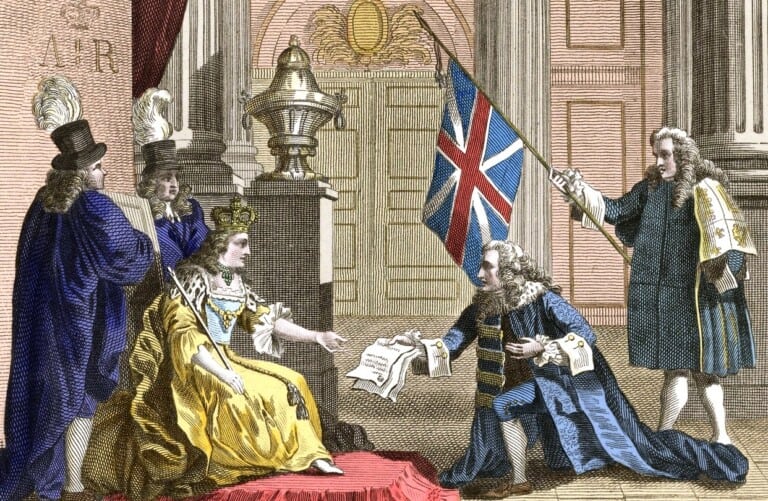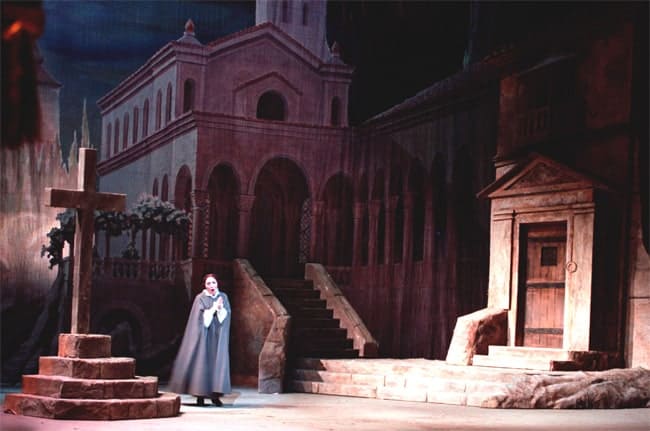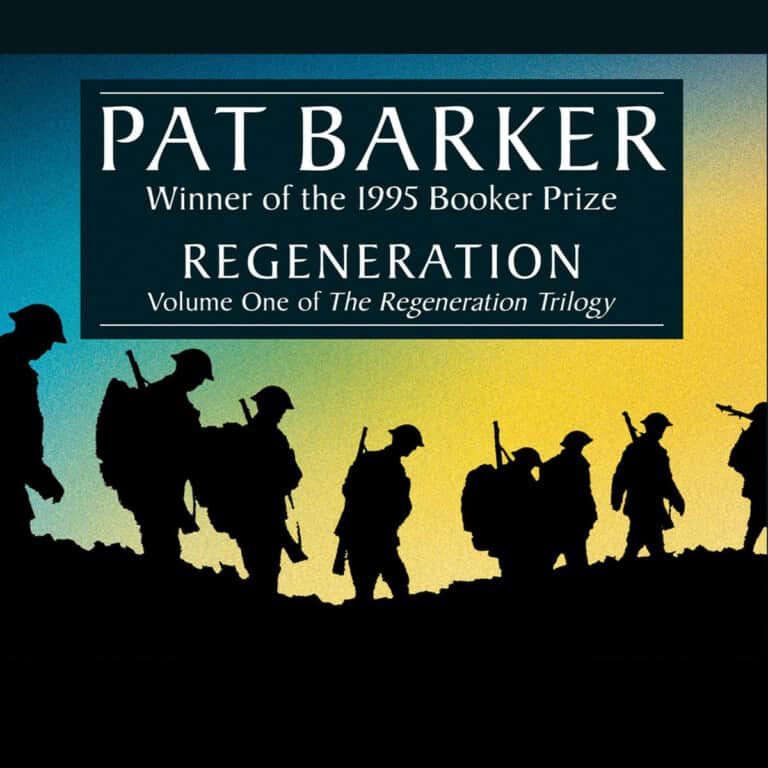Ángel de Saavedra, Duque de Rivas
Ángel de Saavedra, Duque de Rivas, nació en Córdoba el 10 de Marzo de 1791 y murió en Madrid el 22 de Junio de 1865. De familia aristocrática, recibió una vasta educación, con gran influencia de la cultura francesa, que motivó su gusto por la literatura y el dibujo.
Poeta y autor español, Ángel de Saavedra tuvo una vida atormentada. Criado en el seminario de los Nobles de Madrid, fue nombrado oficial de la guardia del Rey y se distinguió en la guerra de la Independencia (1808); condenado a muerte por Fernando VII a causa de sus ideas liberales, consiguió huir y vivió como exiliado durante diez años en Inglaterra, Italia, Malta y Francia.
Vuelve a España tras la amnistía de 1834, hereda el titulo de Duque y una gran fortuna; convertido al conservadurismo, es ministro, presidente del Consejo de Estado, embajador, director de la Real Academia de la Lengua.
Sus primeras poesías y sus primeros dramas muestran la influencia del neoclasicismo (Meléndez, Valdez y Quintana). Luego, el autor se orienta deliberadamente hacia el Romanticismo, con tres obras especialmente célebres.
La primera es un poema en doce romances: El Moro Expósito (1834), que trata de la leyenda del bastardo Mudarra y de sus hermanos. Es un fresco realista y fantástico de las civilizaciones árabe y cristiana en la España de la Edad Media.
El prólogo fue escrito por Alcalá Galiano. Don Álvaro o la fuerza del sino, cuya primera representación tuvo lugar en Madrid en 1835, representó el triunfo del Romanticismo sobre el Escenario; este drama fue en España lo que Hernani había sido en Francia.
Las trágicas aventuras de un héroe perseguido por el sino, el misterio, el amor y la muerte, con una mezcla de tipos y de tonos, lances imprevistos, etc.
Todo contribuye a crear una ilustración clamorosa del romanticismo. El Duque de Rivas se inspiró en la vida real: tuvo una propiedad, “La Jarilla”, en Hornachuelos y conoció la leyenda de la “Mujer Penitente”. Verdi se inspiró en este éxito para su ópera, La Forza del Destino (1862).
El último título glorioso del Duque son sus Romances históricos (1841), que trata de personajes y peripecias de la historia nacional, desde el reinado de Pedro El Cruel hasta la batalla de Bailén.
El Duque de Rivas, tras una vida plena, murió en 1865, pocos días después de la muerte de Antonio Galiano, su gran amigo.
Resumen
Don Álvaro, un indiano rico y misterioso que vive en Sevilla, tiene un romance con doña Leonor, hija del Marqués de Calatrava. Como éste no aprueba esos amores, don Álvaro decide raptar de su casa a doña Leonor. En la huida de los amantes, el Marqués muere accidentalmente. Este hecho da inicio a la tragedia de los protagonistas.
Los enamorados desaparecen. Doña Leonor vive oculta durante un año, de modo que todos, incluso don Álvaro, la creen muerta. Después, se retira al monasterio de los Ángeles, en Hornachuelos.
Don Álvaro viaja a Italia. Los dos hijos del Marqués, don Carlos y don Alfonso, han jurado vengar la muerte de su padre y salen en busca del indiano. En Veletri se encuentran y reconocen don Álvaro y don Carlos, lo que lleva a un duelo donde perece don Carlos. Don Álvaro sobrevive y se refugia en el convento de los Ángeles, en España, donde vive como fraile durante cuatro años.
Por su parte, don Alfonso, que había viajado a Perú, descubre toda la verdad sobre don Álvaro y regresa a buscarle. Segundo duelo obligado, en el cual cae herido don Alfonso. Ambos descubren que doña Leonor vive en la cercana ermita, y don Alfonso, creyéndola cómplice de don Álvaro, la mata.
Para don Álvaro, la única escapatoria a su destino es el suicidio, de modo que se arroja desde la montaña diciendo: «Yo soy un enviado del infierno, soy el demonio exterminador».
Estructura
Este drama está divido en cinco jornadas, cosa típica del teatro neoclásico. Podemos ver que Don Álvaro o la fuerza del sino tiene todas las características del teatro romántico en cuanto a historia, temas y estilo. Pero, en lo que se refiere a las normas neoclásicas de las tres unidades, el Duque de Rivas se tomó muchas libertades:
- Hay diferentes lugares, de España a Italia.
- El drama cubre un periodo de cinco años.
- Hay una acción principal, pero también se intercalan historias costumbristas y cotidianas.
Las differentes jornadas
Primera Jornada
La escena empieza en Sevilla y sus alrededores, cerca del puente de Triana, con la escena cotidiana de un aguaducho. Están presentes el tío Paco, el oficial, una gitanilla que dice la buenaventura.
Observamos un cambio de decoración en la escena V, cuando estamos en casa de Doña Leonor.
Jornada Segunda
La escena tiene lugar en la villa de Hornachuelos, en Córdoba y sus alrededores. Estamos en el mesón de Monipodio. Están presentes el mesonero y la mesonera, un alcalde, un estudiante, un arriero y el tío Trabuco.
La acción principal consiste en el estudiante hablando con mucha cultura y burlándose un poco de los otros, incultos.
Se cambia la decoración en la escena III, nos hallamos en el exterior del monasterio de los Ángeles.
Jornada Tercera
La escena tiene lugar en Italia, en Veletri y sus alrededores. Cuatro oficiales jugando a los naipes. Estamos en una sala. Hay un cambio de decoración en la escena III: aparece una selva. También en la escena V: el teatro representa un risueño campo de Italia.
Otro cambio en la escena VII: estamos en el alojamiento de un oficial superior.
Jornada Cuarta
La escena tiene lugar en Veletri. Esta jornada es la única que no empieza con una escena costumbrista. Nos hallamos de nuevo en el alojamiento militar. La escena II se desarrolla fuera.
El lugar es la plaza principal de Veletri. Están presentes el teniente, el subteniente, Pedraza y unos oficiales. Podemos considerar esta escena como la escena costumbrista.
Jornada Quinta
La escena se desarrolla en el convento de los Ángeles y sus alrededores. Consiste en la sopa del convento. Hay mendigos y lisiados, el Padre Guardián y el Hermano Melitón.
En la escena IV, nos encontramos en una celda. Después, en la escena VIII, volvemos al lugar de la escena I. en la escena IX, nos hallamos fuera, el teatro representa un valle. En este lugar finaliza el drama.
En total, en toda la obra se producen quince cambios de decorado. En cuanto al tiempo, entre el fin de la jornada cuarta y la jornada quinta se produce un salto temporal: Don Álvaro lleva cuatro años retirado en el monasterio de los Ángeles.
Tenemos así que cuatro de las cinco jornadas empiezan con una escena costumbrista, que dan un colorido de romance popular, en contraste con las escenas nobles.
Temas principales
Uno de los temas es el tradicional de la venganza, sobre todo expresada en forma de duelo. Ese anhelo de vengarse parece salvar la honra familiar que ha sufrido una ofensa. En la obra, la furia del Marqués se transforma en deseo de venganza que pasa, como una obligación, a sus hijos.
El inicio del problema está en el amor, o mejor dicho la pasión entre don Álvaro y doña Leonor, que será muy breve porque será destruido por los deberes que la sociedad imponen y por la familia de Leonor.
Pero el tema principal es siempre “la fuerza del sino”, es decir la fatalidad que se abate sobre don Álvaro hasta su muerte. En efecto, esta fatalidad le impedirá vivir su amor con doña Leonor, y acabará matando al Marqués y a sus hijos.
Don Álvaro se sentirá entonces culpable por sus actos y huirá, hasta recluirse durante cuatro años en la soledad de un convento. Por último, pasando de fraile a enviado del infierno, don Álvaro se suicida considerándose «demonio exterminador» y pidiendo al infierno que se lo trague.
Don Álvaro no ha salvado su alma, no ha recibido la divina misericordia. Es éste el conflicto típicamente romántico: el hombre entre Dios y el mundo.
Personajes importantes
Don Álvaro es un indiano rico y de misterioso origen que vive en Sevilla. Está muy enamorado de doña Leonor y quiere fugarse con ella para casarse. Podemos ver a Don Álvaro como la personificación del ser romántico: su sentimiento interior es una mezcla indisoluble de dolor y soledad, y se ve dominado por el destino.
Además, idealiza la amistad, el honor y el amor: por esa razón, siempre se verá decepcionado por la vida terrenal y la única escapatoria a su destino será el suicidio.
Doña Leonor es una doncella aristocrática cuya pasión por don Álvaro provoca inexorablemente los tormentos del alma de su amante y le conduce a la culminación de un destino fatal. Leonor huye a un convento, pasa del sentimiento amoroso al sentimiento de culpa, que a su vez da lugar a la penitencia, en la cual encuentra la muerte.
El Marqués de Calatrava es el padre de doña Leonor, don Carlos y don Alfonso. Parece rígido porque se opone rotundamente a la boda de su hija con don Álvaro, por considerar al pretendiente un aventurero advenedizo. Pero no es la suya la figura de la severidad autoritaria, sino la de un padre que sólo quiere proteger a su hija.
El Marqués sorprende a los dos amantes y trata de impedir su huida pero muere accidentalmente, herido de muerte por el arma de don Álvaro.
Don Carlos es el primer hijo del Marqués. Busca vengar la muerte de su padre y lavar la afrenta a su familia con la sangre de don Álvaro. Se encuentra con don Álvaro y hace amistad con él hasta que descubre su identidad, lo cual lleva al duelo en que perece.
El funesto fin de Don Carlos puede asimilarse al principio vigente en la sociedad de la época: el principio de morir para vengar la honra escarnecida.
Don Alfonso es el segundo hijo del Marqués. También él quiere matar a don Álvaro y a doña Leonor. Encuentra a don Álvaro en un convento y le reta a un duelo, encontrando también él la muerte, no sin antes descubrir la presencia de su hermana en dicho convento y matarla, destrozando una vez más las esperanzas del amante.
Don Alfonso representa la funesta realización del dichoso destino de los dos amantes.
Otros personajes
El ámbito social abarca desde la nobleza de sangre real hasta los mendigos. El ejército está representado por múltiples estamentos: desde el grado de teniente coronel al de preboste u ordenanza. Para la religión tenemos en primer lugar a los franciscanos: Padre Guardián, definido como un siervo de Dios, y el Hermano Melitón, fraile gruñón pero gracioso.
También tenemos al canónigo, digno y prudente, que da lugar a toda la tragedia, y un capellán de regimiento. El alcalde representa la vida política. Encontramos también a un capitán, un cirujano, un estudiante parlanchín, arrieros, un aguador, mesoneros y criados.
Al lado de todos estos personajes, vemos a una gitana, Preciosilla, que parece inspirada en la Gitanilla de Cervantes, el ventero Monipodio, un pícaro sevillano y Félix de Avendaña.
Por último, don Álvaro se presenta con falsas identidades: el militar don Fadrique (que fue realmente hijo de Alfonso XI y de Leonor de Guzmán) y el Padre Rafael en el convento de los Ángeles.
Lengua y efectos estilísticos
Los cincos actos o jornadas, típicos del teatro neoclásico, tienen un doble ritmo: lento y moroso en los deliciosos cuadros de costumbres, rápido y precipitado cuando se pone en tensión el hilo argumental.
El Romanticismo acepta la mezcla de prosa y verso, contradiciendo así la estética neoclásica. El Duque de Rivas, para el verso, admite la diversidad métrica del Barroco, utilizando la redondilla, el romance, la silva y la décima. En Don Álvaro encontramos también unas seguidillas.
La única ley romántica es la ley de la libertad: no son las formas las que se imponen al poeta, es el poeta el que las somete a su sentimiento. Varias asonancias sirven de motivo sentimental que a veces hace adquirir al romance un aire particularmente sinfónico.
La versificación de Don Álvaro es desigual: a veces robusta, bastante fluida y con pocos ripios; llena de prosaísmo en otros casos. Las escenas de rigor argumental están en verso y las episódicas y costumbristas en prosa; con excepción de la escena final de la primera jornada, escrita en prosa rápida, detonante de gritos y maldiciones, y de las dos últimas escenas del drama, con el terrible desenlace, también en prosa entrecortada por exclamaciones imprecatorias.
A través de esta obra, podemos notar la frecuente yuxtaposición de los estilos elevado y llano, la gran variedad y riqueza en el vocabulario y en la estructura de las frases, que ilustran perfectamente todas las situaciones y los estados de ánimo de los personajes.
Bibliografía consultada
- Joaquín Casualdero, Estudios sobre el Teatro Español, publicado en Madrid por Gredos en 1962.
- Gabriel Boussagnol, Angel de Saavedra, Duc de Rivas. Sa vie, son oeuvre, publicado en Toulouse en 1926.
- Miguel de Toro y Gisbert, Larousse Universal, Diccionario en séis volúmenes (tomo tercero), publicado en 1968.
- Duque de Rivas, Don Alvaro o la fuerza del sino (introducción), publicado en Madrid por Catedra – Letras Hispanícas en 1998, edición de Alberto Sanchez.




![Doña Inés (Historia de Amor) por José Martínez Ruiz [Azorín] Doña Inés (Historia de Amor) por José Martínez Ruiz [Azorín] photo](https://www.skyminds.net/wp-content/uploads/2007/07/dona-ines-historia-de-amor-768x432.jpg)
